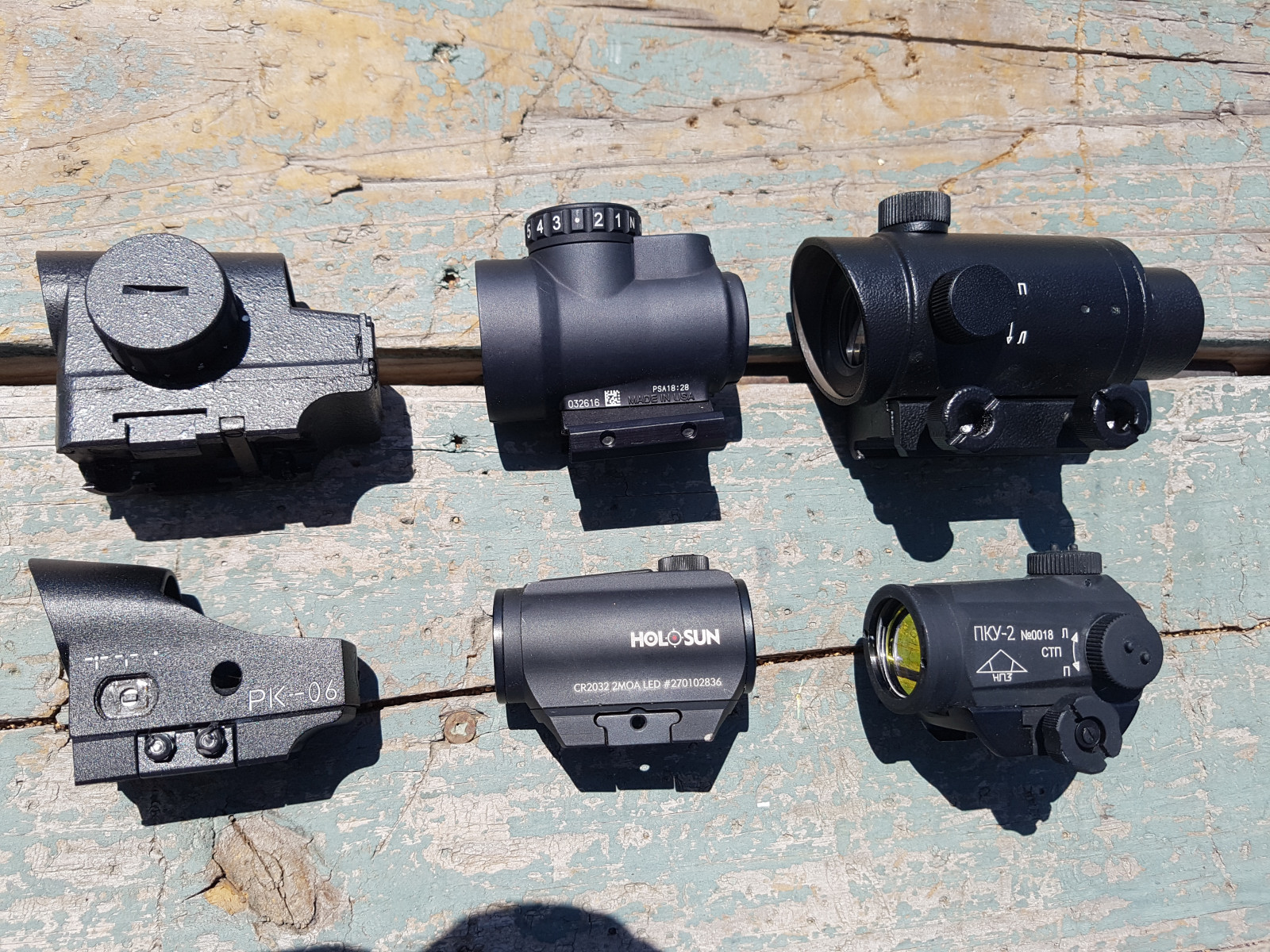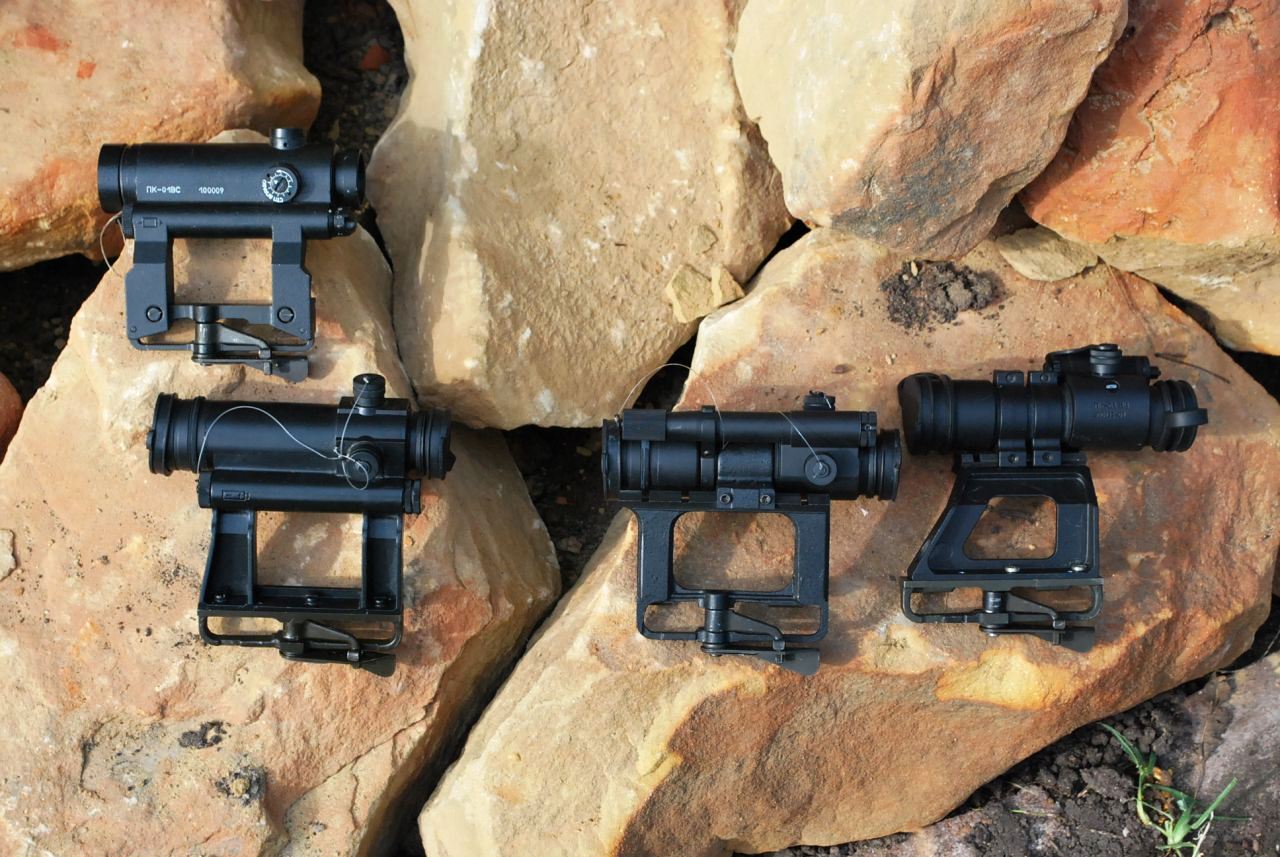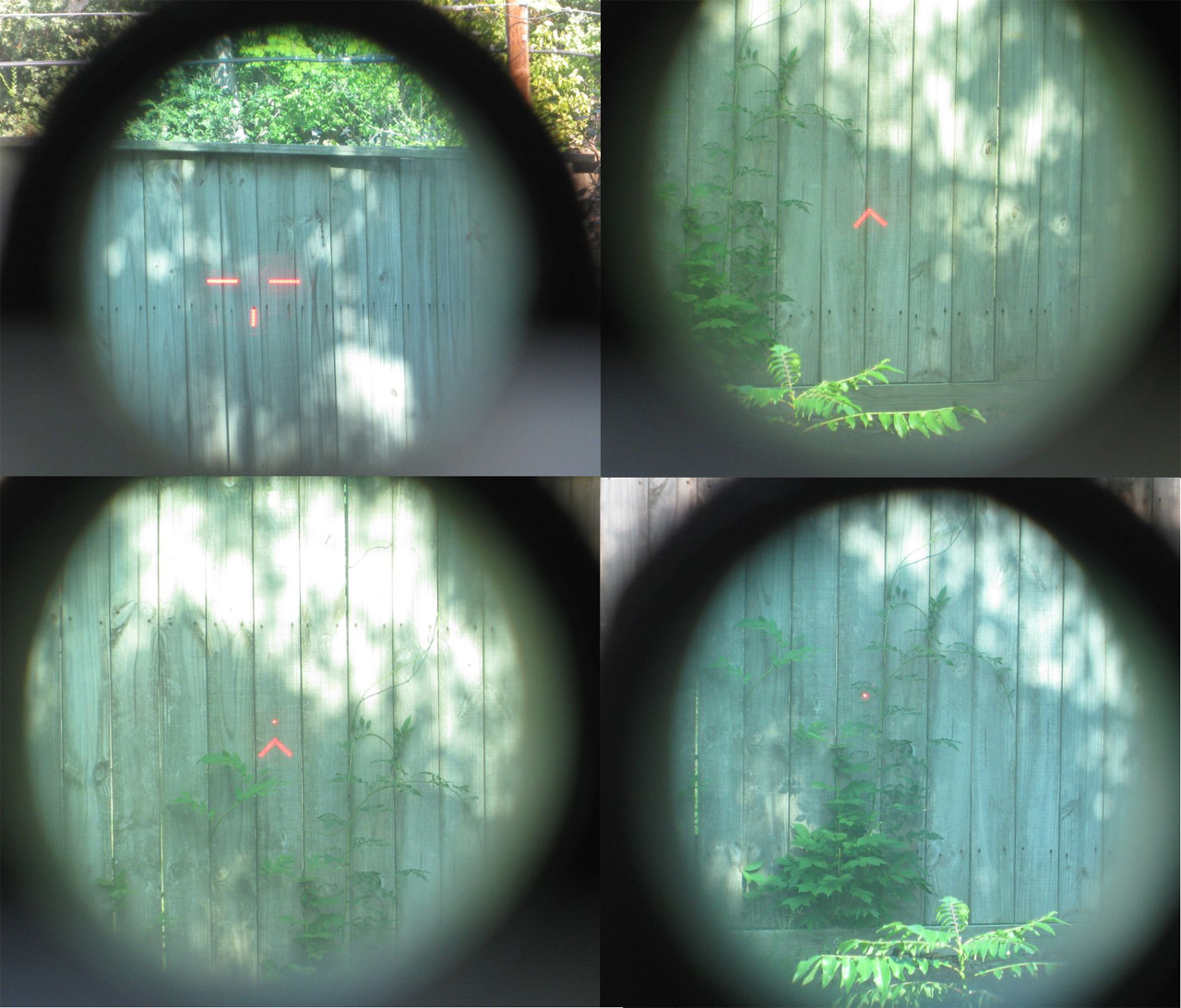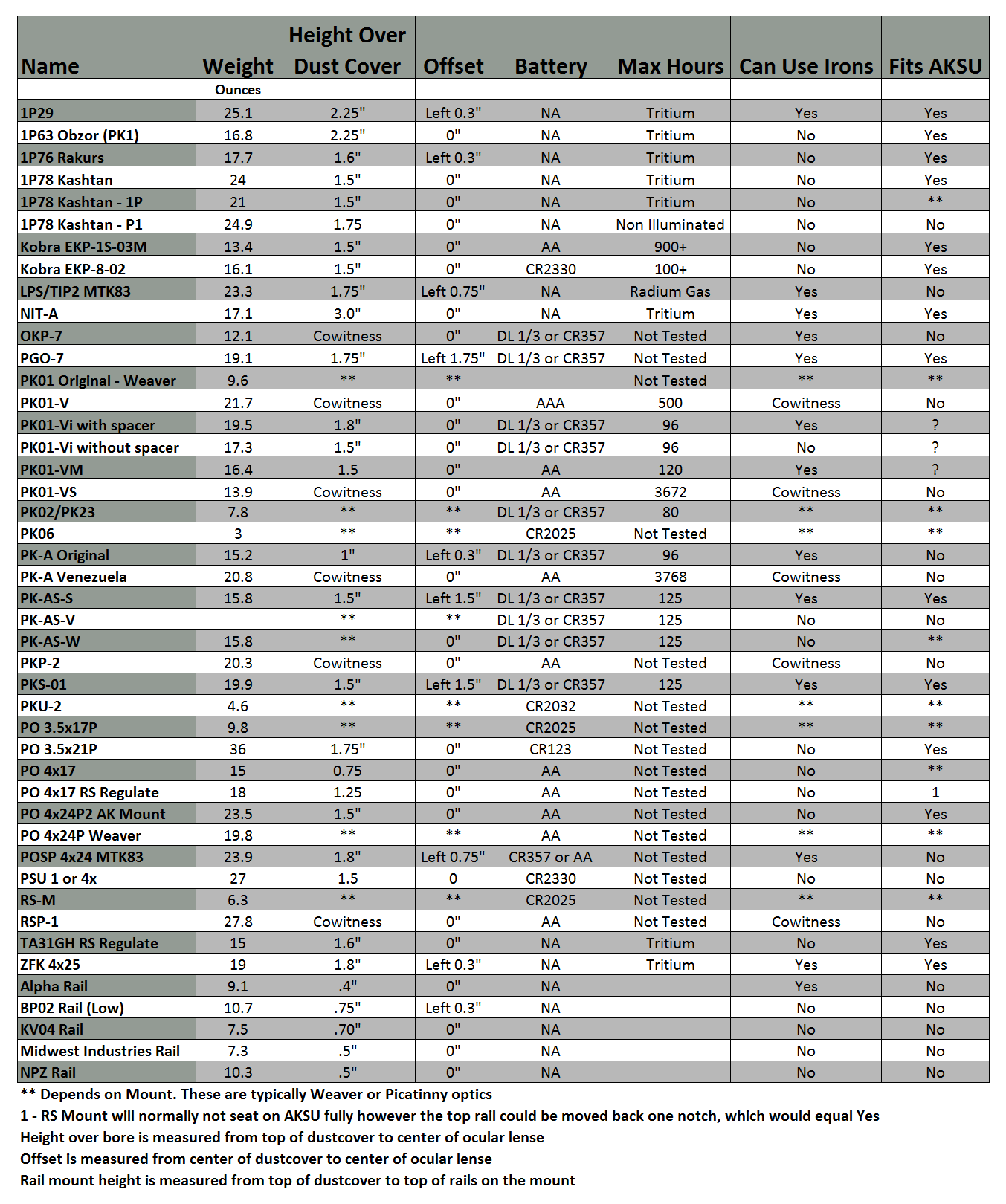 Russian and Belorussian
optical manufacturers have produced a variety of
traditional red dot type optics along with more
interesting collimator optics that we might not be as
familiar with in the West. As a general rule my
experience is that all of these optics work well (or
best) with both eyes open and are designed to be fast
acquisition CQB optics as you would expect. Some of
the them use a true collimator design which gives
excellent light gathering properties and very clear
field of view. Tritium is also an effective addition
for low light use without batteries on some models.
Russian and Belorussian
optical manufacturers have produced a variety of
traditional red dot type optics along with more
interesting collimator optics that we might not be as
familiar with in the West. As a general rule my
experience is that all of these optics work well (or
best) with both eyes open and are designed to be fast
acquisition CQB optics as you would expect. Some of
the them use a true collimator design which gives
excellent light gathering properties and very clear
field of view. Tritium is also an effective addition
for low light use without batteries on some models.
There are such a large number of red dot type optics
that it will be extremely difficult to have a hands on
detail for them all, therefore a few of them will be
dealt with in a general means only.
***
To help out new users not as familiar with these
optics in terms of what to buy, this is how I stack
the red dots up against each other. If the optic is
not on the list it doesn't mean it's not effective it
just means that it's not doing anything better than
the best of them.
Red Dot:
PK01-VS
RS-M
PK-A Venezuela
Kobra
PK01-V
Collimator:
Obzor
Rakurs
PK-AS
OKP-7
Not a huge fan:
PK01-Vi
PK01-VM
PK06
As of March 2017 PKU-2 is too new for me to
recommend over other proven dots, but I am looking
forward to using it and fully expect it to be in the
top 5
***
Also of note:
PK series battery test completed September 4th 2012
Kobra battery test from AR15.com
Top Left to Right
PK01-Vi
Rakurs
Obzor
PK01-VS
Bottom Left to Right
PK23
PK-AS
PK-A Original
Kobra
Top Left to Right
RS-M
Trijicon MRO
Rakurs-PM
Bottom Left to Right
PK06
Holosun
PKU-2
Generally speaking the red dot and collimator
optics are not caliber specific and typically do not
have range adjustments or turrets for windage or
elevation adjustments on the fly. In effect they are
zeroed to the rifle in question and then the shooter
will use hold overs to correct for distance or wind,
with the design obviously being optimized for CQB
and/or relatively close range engagements. It is also
very common for Russian red dots to have much smaller
1.5 MOA or 2 MOA dots. Depending on range and lighting
conditions this can make the dots slightly harder to
acquire than the older Aimpoint 3.8 MOA dot, but IMO
the tradeoff is more precise aiming at longer ranges.
It should also be noted that Aimpoint and Trijicon now
use 2 MOA dots as their standard size, something the
Belorussians have been doing for 15 years or more
In my personal experience I have found that I prefer
the collimator types over the tubular red dots for a
few reasons that matter to me. The main feature I
prefer about the collimator types is the reticule type
that many have...chevron, triangle or German Post is
very common, vs the simple dot of the tube optics.
What I like about the chevron type reticule is that it
is large enough for good close range CQB but can be
zeroed so that point of impact is at the tip, allowing
for precise aiming at longer ranges. Effectively the
reticule is large enough to acquire as quick or
quicker than a red dot but also allows for long range
shooting as well. To me this is the best of both
worlds and a feature that I have come to respect about
the Russian collimators.
Another feature I really like is the use of always-on
reticule designs like Rakurs, PK-AS and Obzor,
combined with tritium for low light shooting. This
means no batteries to worry about... period.
On the one hand because many Russian optics have
two weeks and longer battery
life on max brightness (with Aimpoints having
YEARS of battery life), and also because it's pretty
easy to keep spare batteries, you can argue that an
always-on reticule may not be the absolute be-all,
end-all in optic design...but on the other hand it
means that the rifleman does not have to do anything
to the optic at all to make it combat ready. Zero once
and forget about it, literally. There are no on/off
controls or other brightness controls to get the most
modern Russian optics ready for shooting.
I tend to prefer the simplicity of the collimators but
one tradeoff will be replacing the tritium in 10 years
vs swapping batteries. I don't believe in worrying
about whether tritium will fade out in combat
conditions right when you need it most, but it is a
valid concern on how to replace the tritium at some
point when it finally dies. It has been possible to
relight the Soviet
1P29 optic and it may be possible to relight
Rakurs or Obzor should the need arise.
Since collimators basically use the general design of
magnified scopes but at 1x magnification they tend to
have much higher light gathering properties than
tubular red dots. This comes in handy as low light
conditions set in, and in my experience I feel that
collimator optics like PK-AS and Rakurs do better in
low light than other Russian red dot tube designs like
PK23 or PK-A for example.
It is also often said that Russian optics are much
taller than many Western optics mounted on AR type
rifles and I think this is generally a true statement.
The effect becomes a chin weld vs the more common
cheek weld of the AR but in my experience I have not
seen much practical difference during shooting. I'd
think it's logical to assume a cheek weld will give
tighter groups in general, but under what I'd consider
combat shooting the chin weld is still going to allow
the rifleman to hit man size targets reliably even if
the group size is larger than what might have been had
with a cheek weld. In the end I believe the difference
is not as much absolute as it is philosophical or
doctrinal and during shooting I haven't noticed much
difference personally. While I have been trained on
the M16A2 with a nose to charging handle cheek weld, I
haven't had any issues adapting to the higher chin
weld of many Russian optics.
Two other points to think about is CQB and the use of
ballistic helmets like K6-3
Atlyn. While I do not claim to be a CQB expert
it does seem that the higher head position helps
quicker shooting during close range engagements, and
in the case of ballistic helmets it can be difficult
or impossible to get on the sights if they are very
low.
Top Left to Right
PK01-VS
PK01-VM
PK01-V
PK01-Vi
Obzor reticule
Kobra 4 pattern reticule



